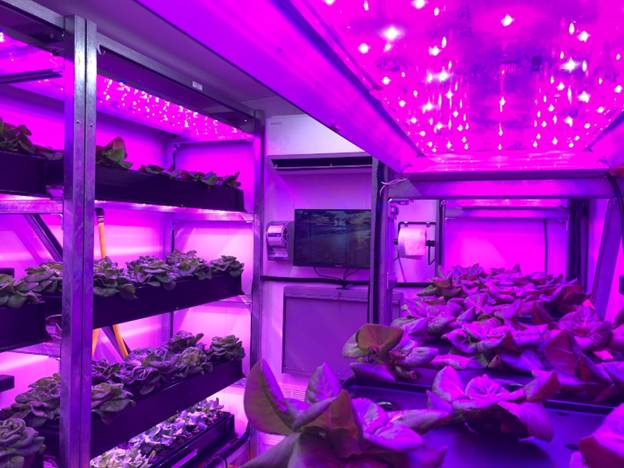How indoor agriculture can serve as a local food source in northern—and urban—settings
Vertical farming is a form of controlled environment agriculture (CEA), that gives growers more control over the environment they tend their crops in, which can be advantageous in challenging growing conditions.
Indoor vertical farming was set to take off in a big way, but lacklustre investment returns and scaling challenges has limited production.
“There was a big bubble around this industry that has more or less burst over the past four years,” said Dr. Alesandros Glaros, Food and Agriculture Institute, University of the Fraser Valley. “The companies that have weathered the storm are patient and have invested substantially in research and development. They have tried and true technologies, are integrated into strong local and regional supply chains, and are highly collaborative. Now, we can find their vertically grown, competitively priced leafy greens in remote regions as well as major grocery stores.”
There are examples of innovations in the space. British Columbia-based QuantoTech Solutions, a vertically integrated ag-tech company, has developed a growing system that features 8 by 12 feet sheds with shelving units to allow for vertical farming, producing 4.8 between 7.2 tonnes of food per year, including leafy greens, strawberries, and cherry tomatoes. Each unit requires approximately 37.2 to 52 gigajoules of energy per year, which is less than the energy needed to power the average Canadian home1. The mobile units were originally developed for northern and challenging growing conditions, but are also suitable for urban settings.

A food source for northern and remote communities
Northern and remote communities face many barriers in accessing fresh fruits and vegetables, which are often of poor quality and high cost by the time they reach northern communities from production or distribution centers below the 49th parallel. Indoor vertical farms are not capable of addressing northern food insecurity alone or replacing traditional Indigenous food sources, but can contribute to raising the region’s supply of local, fresh vegetables and fruit.
Key considerations for indoor agriculture in northern and remote communities:
1. Investing and scaling. The timescale for return on investment and availability of grants to support upfront and operational costs are critical before growers can invest in starting, or scaling, indoor farming.
2. Energy source and use. Around 178 remote Indigenous and northern communities in Canada rely on generators powered often by diesel fuel as they are not connected to the North American electricity grid and natural gas infrastructure2.
3. Growing yields. Sustaining operations require streamlining access to inputs and improvements in yields. Developing and maintaining access to suppliers and local vertical farming expertise is key.
Building up urban agriculture
The indoor vertical ecosystem can easily be replicated in urban settings, which have their own set of challenges. Connections to agriculture production in large urban areas is increasingly less common as our cities expand and demand rises, placing a high need for commercial scale production with streamlined supply chains. Indoor vertical farms that can be integrated within building developments and retrofits is one pathway to provide urban dwellers with fast access to local produce, as well as potentially contributing to cities and the building sectors’ decarbonization efforts.
Key considerations for indoor agriculture in urban areas:
1. Connecting consumers. Encouraging consumers to get their greens from a local vertical farm will require awareness and ease of access.
2. Making the case. More energy, more space, and more investments are needed to scale indoor vertical farms in or close to urban areas and the return on investment must be there to justify further development.
3. Planning land use. Urban areas are home to intense competition for land. Throwing food production into the mix should be strategically aligned to city planning, collaborative with municipalities, and meet local needs.
Indoor vertical farming could evolve as a mainstream source of food across Canada, if it improves the business case in scaling production. But for now, its strength is in meeting niche, local market demands.
Lisa Ashton is Agriculture Policy Lead at RBC Climate Action Institute.
- Statistics Canada. (2024). Household energy consumption, Canada and provinces.
- Canada Energy Regulator. (2023). Market Snapshot: Clean Energy Projects in Remote Indigenous and Northern Communities.
This article is intended as general information only and is not to be relied upon as constituting legal, financial or other professional advice. The reader is solely liable for any use of the information contained in this document and Royal Bank of Canada (“RBC”) nor any of its affiliates nor any of their respective directors, officers, employees or agents shall be held responsible for any direct or indirect damages arising from the use of this document by the reader. A professional advisor should be consulted regarding your specific situation. Information presented is believed to be factual and up-to-date but we do not guarantee its accuracy and it should not be regarded as a complete analysis of the subjects discussed. All expressions of opinion reflect the judgment of the authors as of the date of publication and are subject to change. No endorsement of any third parties or their advice, opinions, information, products or services is expressly given or implied by Royal Bank of Canada or any of its affiliates. This document may contain forward-looking statements within the meaning of certain securities laws, which are subject to RBC’s caution regarding forward- looking statements. ESG (including climate) metrics, data and other information contained on this website are or may be based on assumptions, estimates and judgements. For cautionary statements relating to the information on this website, refer to the “Caution regarding forward-looking statements” and the “Important notice regarding this document” sections in our latest climate report or sustainability report, available at: https://www.rbc.com/community-social- impact/reporting-performance/index.html. Except as required by law, none of RBC nor any of its affiliates undertake to update any information in this document.


